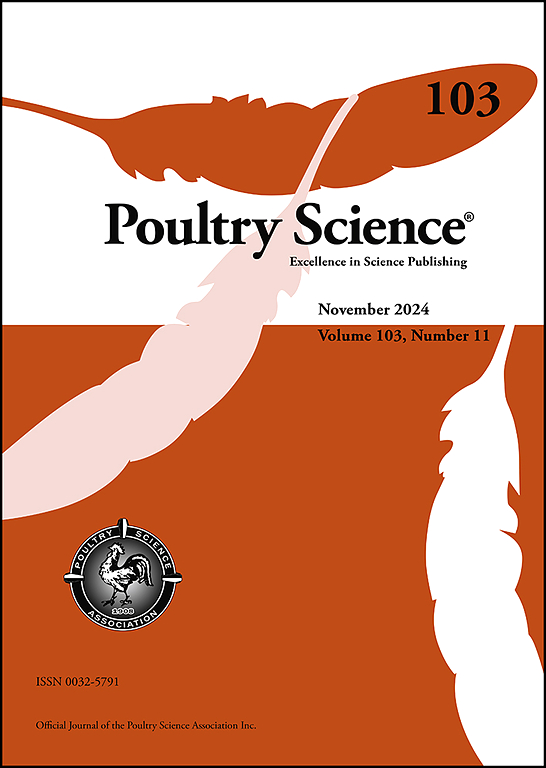Temporal transcriptome profiling in the response to Salmonella enterica serovar enteritidis infection in chicken cecum
IF 3.8
1区 农林科学
Q1 AGRICULTURE, DAIRY & ANIMAL SCIENCE
引用次数: 0
Abstract
Salmonella enterica serovar Enteritidis (S. Enteritidis) is a common zoonotic pathogen that not only causes gastroenteritis or death of livestock and poultry but also poses a serious threat to human health, causing severe economic losses to the poultry industry and society. Herein, RNA-sequencing (RNA-seq) was used to analyze the transcriptome variation of chicken cecum at four different time points (1, 3, 7, and 14 days) following S. Enteritidis infection. There were 529, 1477, 476, and 432 differentially expressed genes (DEGs) in the cecum at four different days post-infection (dpi), respectively. The DEGs were significantly enriched in various immune-related pathways on 3 dpi and 7 dpi, such as cytokine-cytokine-receptor interaction and Toll-like receptor signaling pathway. DEGs were significantly enriched in several metabolic pathways on 14 dpi. Gene ontology (GO) enrichment of DEGs showed that up-regulated genes were significantly enriched in immune-related terms on 3 and 7 dpi. On 14 dpi, up-regulated genes were mainly enriched in the signaling-related terms, while the down-regulated genes were primarily enriched in the metabolic-related terms. Based on weighted gene co-expression network analysis (WGCNA), the key modules related to energy, non-coding processes, immunity, and development-related functions were identified at 1, 3, 7, and 14 dpi, respectively, and 5, 8, 6, and 5 hub genes were screened out, respectively. This study demonstrated that the chicken cecal transcriptome regulation responding to S. Enteritidis infection is time-dependent. The regulation of S. Enteritidis infection in chickens is coordinated by multiple systems, mainly involving immunity, metabolism, and signal transduction. Both 3 and 7 dpi are key time points for immune response. As the infection progresses, metabolism-related pathways were increasingly identified. This change reflects the dynamic adjustment between immune response and metabolism in Jining Bairi chickens following S. Enteritidis infection. These results suggested that starting from 3 dpi, the chickens gradually transition from an immune response triggered by S. Enteritidis infection to a state where they adapt to the infection by modulating their metabolism.
鸡盲肠对肠炎沙门氏菌血清型感染反应的时间转录组分析。
enterica serovar Enteritidis (S. Enteritidis)是一种常见的人畜共患病原体,不仅引起畜禽肠胃炎或死亡,而且严重威胁人类健康,给家禽业和社会造成严重的经济损失。本文采用rna测序(RNA-seq)技术分析了肠炎沙门氏菌感染后4个不同时间点(1、3、7和14天)鸡盲肠的转录组变化。感染后4天盲肠差异表达基因(deg)分别为529、1477、476和432个。deg在3 dpi和7 dpi上的各种免疫相关通路中显著富集,如细胞因子-细胞因子-受体相互作用和toll样受体信号通路。14 dpi时,多种代谢途径中deg显著富集。基因本体(GO)富集的DEGs显示,上调基因在3和7 dpi显著富集免疫相关术语。在14 dpi时,上调基因主要富集于信号相关项,下调基因主要富集于代谢相关项。基于加权基因共表达网络分析(WGCNA),分别在1、3、7和14 dpi处鉴定出与能量、非编码过程、免疫和发育相关功能相关的关键模块,并分别筛选出5、8、6和5个枢纽基因。本研究表明,鸡盲肠转录组对肠炎沙门氏菌感染的响应具有时间依赖性。鸡肠炎沙门氏菌感染的调控是由多个系统协调的,主要涉及免疫、代谢和信号转导。3和7 dpi都是免疫反应的关键时间点。随着感染的进展,代谢相关途径越来越多地被发现。这一变化反映了济宁百日鸡感染肠炎沙门氏菌后免疫反应和代谢的动态调节。这些结果表明,从第3 dpi开始,鸡逐渐从肠炎沙门氏菌感染引发的免疫反应过渡到通过调节代谢来适应感染的状态。
本文章由计算机程序翻译,如有差异,请以英文原文为准。
求助全文
约1分钟内获得全文
求助全文
来源期刊

Poultry Science
农林科学-奶制品与动物科学
CiteScore
7.60
自引率
15.90%
发文量
0
审稿时长
94 days
期刊介绍:
First self-published in 1921, Poultry Science is an internationally renowned monthly journal, known as the authoritative source for a broad range of poultry information and high-caliber research. The journal plays a pivotal role in the dissemination of preeminent poultry-related knowledge across all disciplines. As of January 2020, Poultry Science will become an Open Access journal with no subscription charges, meaning authors who publish here can make their research immediately, permanently, and freely accessible worldwide while retaining copyright to their work. Papers submitted for publication after October 1, 2019 will be published as Open Access papers.
An international journal, Poultry Science publishes original papers, research notes, symposium papers, and reviews of basic science as applied to poultry. This authoritative source of poultry information is consistently ranked by ISI Impact Factor as one of the top 10 agriculture, dairy and animal science journals to deliver high-caliber research. Currently it is the highest-ranked (by Impact Factor and Eigenfactor) journal dedicated to publishing poultry research. Subject areas include breeding, genetics, education, production, management, environment, health, behavior, welfare, immunology, molecular biology, metabolism, nutrition, physiology, reproduction, processing, and products.
 求助内容:
求助内容: 应助结果提醒方式:
应助结果提醒方式:


